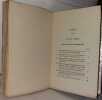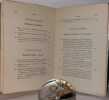1781 books for « klein f »Edit
-
Type
Book (1797)
Engraving (1)
Magazine (3)
Music sheets (12)
Posters (1)
-
Latest
Last 24h (2)
Last month (90)
Last week (2)
-
Language
English (8)
French (1784)
German (3)
Russian (19)
-
Century
16th (1)
18th (2)
19th (49)
20th (757)
21st (239)
-
Countries
Belgium (105)
Canada (8)
Denmark (30)
France (1514)
Germany (1)
Greece (1)
Netherlands (8)
Switzerland (127)
United Kingdom (1)
United States of America (19)
-
Syndicate
ALAC (7)
CLAM (9)
CLAQ (3)
CNE (1)
ILAB (758)
NVVA (19)
SLACES (19)
SLAM (683)
SNCAO (1)
Topics
- Abraham (6)
- Agriculture (4)
- Alsace (135)
- Anticipation (10)
- Architecture (20)
- Army (15)
- Asia - orient (11)
- Austria (4)
- Autographs (7)
- Bible (4)
- Biography (22)
- Catholicism (6)
- Ceramic (7)
- Children’s books (14)
- Christianity (10)
- Christmas (11)
- Cinema (9)
- Colette (6)
- Collections (4)
- Colson jean (6)
- Comic strip (8)
- Contemporary look (5)
- Cooking (5)
- Dedication (10)
- Dog (the) (12)
- Early printed books (5)
- Economics (9)
- Education (8)
- Education - morals (7)
- English (13)
- Esotericism (9)
- Essays (4)
- Europe (5)
- Fantastic (11)
- Fine arts (25)
- First edition (10)
- Florence (5)
- Furniture (13)
- Furniture (12)
- Geography (13)
- Germanic languages (17)
- Germany (12)
- Gudmundur gudmundsson (6)
- Guide books (6)
- History (80)
- Industrial arts & crafts - fine arts (20)
- Iron (8)
- Ironwork (4)
- Israel (5)
- Japan (7)
- Judaism (judaica) (8)
- Klein charles armand (16)
- Klein félix abbott (6)
- Klein gérard (70)
- Klein jean (9)
- Klein robert (19)
- Literature (143)
- Lorrain (11)
- Magazine (10)
- Malacology (6)
- Mathematics (23)
- Medicine (11)
- Military arts (6)
- Monographs (5)
- Music (6)
- Navy (8)
- Newspapers press (15)
- Painting (7)
- Palaeontology (5)
- Paris (9)
- Philology (6)
- Philosophy (23)
- Photography (37)
- Physics (28)
- Poetry (7)
- Policy (7)
- Psychiatry neurology (6)
- Psychoanalysis (26)
- Psychology (35)
- Regionalism (4)
- Religions (22)
- Review (16)
- Reviews (12)
- River (18)
- Road (6)
- Science fiction (23)
- Sciences (24)
- Scores (30)
- Shelley (9)
- Short stories (4)
- Sociology (7)
- Songs (17)
- Theatre (9)
- Theology (8)
- Travel (10)
- United states (13)
- Various (17)
- War (27)
- Wine (4)
- Youth (9)
Godel Durckheim Jourdain Khan Londe Cercoustre Linssen Klein Atreya Lebail
Reference : 100141623
(1965)
L'homme et la connaissance
Le courrier du livre 1965 in8. 1965. Broché.
couverture défraîchie accroc en haut de la charnière du premier plat intérieur propre
6 livres - Les grandes découvertes de la psychanalyse: L'identification les névroses le ça le moi le surmoi la sublimation les écoles psychanalytiques le complex de castration
Tchou 1978 in8. 1978. Broché. 6 volume(s).
Bon état intérieurs propres couvertures un peu défraichies légères ternissures sur les tranches bonne tenue par ailleurs
Rabin un assassinat politique + Les fous de la Paix + La démocratie d'Israël + Les relations secrètes israélo-palestiniennes --- 4 livres
Le Monde / Laffont / Seuil / Plon / Balland 1996 in8. 1996. Broché. 4 volume(s).
Bon état bonne tenue intérieurs propres
Meeting the Great Bliss Queen: Buddhists Feminists and the Art of the Self
Beacon Press 1994 325 pages in8. 1994. Cartonné jaquette. 325 pages.
Bon état avec sa jaquette tranche un peu ternie intérieur propre
Les Méthodes de Travail de Gersonide Et Le Maniement Du Savoir Chez Les Scolastiques (Etudes De Philosophie Médiévale Band 86)
Vrin 2025 392 pages 16x2 4x23 4cm. 2025. Broché. 392 pages.
Très Bon Etat de conservation intérieur propre bonne tenue
Votre vie et votre caractere sur votre visage
Rtl 1988 141 pages in-8. 1988. broché. 141 pages.
Bon Etat
Les théories hermétiques de la médecine traditionelle en Chine
Dervy livres 1987 202 pages in-8. 1987. broché. 202 pages.
Bon Etat
La séparation aux états unis Histoire lois coutumes documents
Librairie Bloud et cie 1908 126 pages in-12. 1908. Broché. 126 pages.
Bon état dos un peu bruni un tampon derrière page de titre intérieur très bon bonne conservation de la couverture
Marie Raymond
Expressions contemporaines 2004 239 pages in4. 2004. Relié. 239 pages.
Très bon état coins très légèrement usés
PETIT VOYAGE ICONOCLASTE EN PSYCHOPATHOLOGIE
PU GRENOBLE 2006 317 pages 13 6x2 2x20 4cm. 2006. Broché. 317 pages.
proche du neuf
Abraham Chasseguet-Smirgel Frenczi Freud Karen Horney Jones Mélanie Klein Laclaire De Monchy Rank Segal Stärcke Van der Leeuw Van Ophüijsen
Reference : 100125582
(1978)
ISBN : 2710700972
Le Complexe de castration: Un fantasme originaire (Les Grandes decouvertes de la psychanalyse) (French Edition)
Tchou 1978 in8. 1978. Broché.
bon état de conservation coin inférieur taché intérieur propre
Klein Denis Gallet Ponnau Baulez Samoyault Sahut Caucheteux Gaborit Delpierre
Reference : 100119724
(1992)
Madame Du Barry de versailles à louveciennes
Flammarion 1992 in4. 1992. Cartonné jaquette.
avec sa jaquette intérieur frais bonne tenue
Grandes idées de la science Tome 1 Einstein et la relativité
RBA FRANCE 2014 16 69x23 19x2 82cm. 2014. Relié.
Très bon état
Études françaises - neue ausgabe B für Mittel- und Realschulen - BAND Mi B 1
Ernst klett verlag in8. Sans date. Cartonné.
Bon Etat de conservation bords un peu frottés intérieur propre quelques notes au début du livre circa 1950
Stendhal " Le Rouge Et Le Noir "
Hatier / Profil d'une oeuvre 1984 poche. 1984. broché.
Bon Etat
Deutsche Keramik: Von den Anfangen bis zur Gegenwart (German Edition)
Wasmuth 1993 23x27x2cm. 1993. Relié. abondante iconographie noir et blanc et couleurs
Très bon état (TB)
Le diocèse des barbelés1940-1944
Fayard 1973 in8. 1973. Cartonné.
Bon état (BE) cependant bords jaquette ternie intérieur propre jauni
Le paysan dépaysé - Le président est en Sologne - théâtre
Clairmirouère du temps 1985 in12. 1985. Broché. illustrations noir et blanc
Bon état général cependant couverture défraîchie bords un peu frottés qq ternissures intérieur propre
Le paysan dépaysé - Le président est en Sologne - théâtre
Clairmirouère du temps 1985 in12. 1985. Broché. illustrations noir et blanc
Bon état général cependant couverture défraîchie bords un peu frottés qq ternissures intérieur propre étiquette sur le premier plat
Jackie
Presses de la Cité 1999 438 pages in8. 1999. broché. 438 pages.
Très Bon Etat-tranche inférieur un peu salie
Le fer forgé dans la maison + Escaliers et rampes -- 2 livres
Charles massin 1965 in4. 1965. Cartonné.
Bon état des livres qq rousseurs sur tranche intérieurs propre avec jaquettes (bords défraîchies) circa 1965
Le fer forgé dans la maison
Massin et cie 1965 in4. 1965. Cartonné. illustré en noir et blanc
livre en bon état qq rousseurs sur la tranche supérieure avec sa jaquette (bords frottés) intérieur propre
Le long voyage (La saga d'Argyre)
J'ai lu / Science fiction n°2324 1988 157 pages poche. 1988. broché. 157 pages.
Bords de la couv frottés-texte bon
Déluge d'acier
Gerfaut 1976 221 pages in12. 1976. Broché. 221 pages.
Etat Correct pages + tranche jaunies
 Write to the booksellers
Write to the booksellers














































